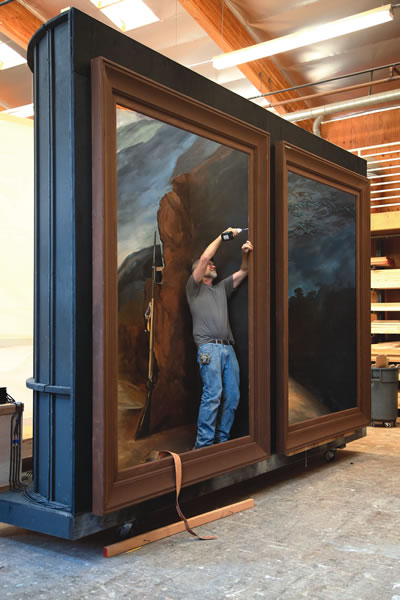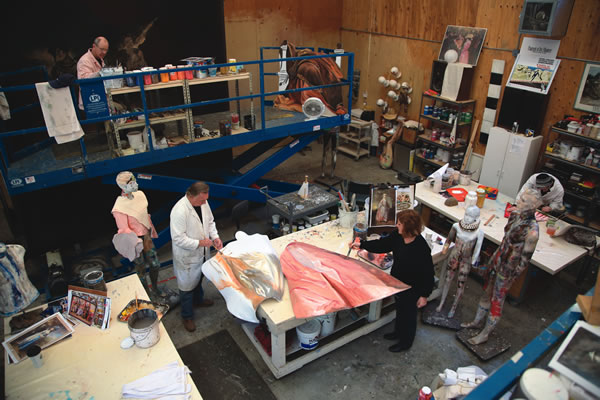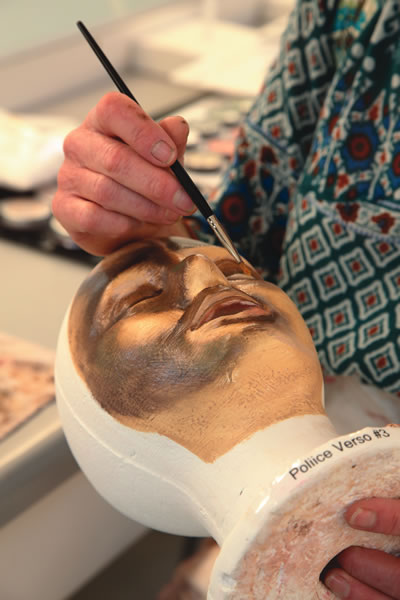The Pageant of the Masters’ “living pictures” is an elaborate alchemy of theater and art.
By Bruce Porter | Photos by Jody Tiongco
Before the final curtain call every year at the end of August, Pageant of the Masters Director Diane Challis Davy has already begun work on the next year’s show. Now celebrating its 80th anniversary, this beloved production of tableaux vivants, or living pictures, takes the stage at the Irvine Bowl to captivate audiences each year, like clockwork. And the cogs never stop turning, even after the last applause dies away.
“There’s no greater sin in theater than being boring,” Dan Duling, the pageant’s scriptwriter, explains. “[Diane is] a director who wants to take risks, who doesn’t want to repeat herself if she can help it. So we’re constantly looking for ways to keep the show exciting, whether you’re an art historian or someone who is just looking for an entertaining evening out.”
Unlike any other production in theater arts, the Pageant is a stimulating reminder of the import of fine art in our contemporary, often oblivious, secular world. Faithful recreations of classical and modern works are staged in 90-second freeze-frame segments, with actors playing the roles of the subjects in the original pieces.
Enormous set designs are constructed and painted so that when costumed actors step into their cutaway spots and the lights are angled just so, the presentation is a near-exact replica, yet on a grand life-size scale. Add a complementary orchestral score of predominately original music and a narrator who provides fascinating commentary, and the result is simply astonishing.
Themes are chosen with an eye toward showcasing a broad variety of art pieces. In marked contrast to last year’s contemplative theme, “The Genius,” this summer’s production is entitled “The Big Picture”—a broad, fun and dynamic examination of the relationship between traditional art and film.
“We started out with the idea that great art influences the production of motion pictures,” Diane says. “But it’s not even that narrow. We’ll have representations of movie posters, early still photography—which led to motion pictures—and painters who inspired film directors.”
This year’s ticket holders can expect to learn how the works of 18th century English portrait and landscape artist Thomas Gainsborough influenced film director Stanley Kubrick, and the connection between the academic art of Jean-Leon Gerome and Ridley Scott’s “Gladiator.” Alfred Hitchcock will make more than a cameo appearance. And, at the risk of giving too much away, everybody’s favorite 1980s high school slacker, Ferris Bueller, is sure to put a smile on the 2,600 faces in the audience.
 Abracadabra
Abracadabra
While 17th-century Dutch painter Johannes Vermeer, whose “Girl with a Pearl Earring”—referred to as the “Dutch Mona Lisa”—is reputed to have made only 34 paintings in his lifetime, pageant staff and volunteers are consigned to recreate 40 larger-than-life master works in just six months.
It’s a daunting task by any measure, made all the more impressive by the fact that there are only about 20 full-time staff members. Characterizing her 18 years as the director, Diane quips that she has “never had a relaxing summer vacation.”
Once the theme has been chosen, research volunteers gather information on possible works of art appropriate to the theme. Paintings and sculptures must be adaptable to the production’s concept. Copyrights and permissions from museums are obtained, and the artworks are put before the Festival of Arts’ board members for approval. Then the work begins in earnest.
“Way back in September, I’m putting up my storyboard,” Diane says. “I’m counting the number of cast members required because we have limitations on how many people we can adequately make up and costume backstage.”
Design issues fall under the purview of Richard Hill, whose challenges begin as soon as the list of artworks is approved in late October, and it doesn’t let up until the last painting has been rehearsed the following June, just days before opening night. It’s his job to map the architecture of each work, transforming two-dimensional images into 3-D set pieces that include live subjects, using tricks of stage design and lighting to retain the original work’s detail and perspective for the entire audience, whether a viewer is front and center or 26 rows back on the left.
“The biggest factor [in creating the illusions] is in the painting and the lighting,” Diane says. “The painter and makeup artist create middle tones of [artificial] shadows, and the lighting will eliminate all the real shadows. That’s what makes our paintings look very flat.”
“For each individual piece, I scale it to human proportions on the computer,” Richard says. “Then the image is projected onto the set so the artists can trace an outline before they start painting.”
Sculptures are even more complicated than paintings to replicate. Last year’s “Mechanics Monument” by Douglas Tilden, a landmark sculpture in San Francisco of five capable-looking men struggling with an oversized punch-press machine, presented challenges not merely from an aesthetic perspective but also anticipating potential problems that could jeopardize the safety of the actors.
The sculpture had to appear a faithful reproduction from all angles, as it was drawn to be viewed on a rotating pedestal. Unfortunately for Richard, artists are invariably inclined to favor interpretive license over physical limitations. Of the five bronze mechanics, the three on the lever are positioned at angles that are seemingly impossible to recreate. Yet, with the assistance of a steel skeleton supporting the sculpture and obscured harnesses and armatures, the segment proved to be one of the highlights of the show.
Sleight of Hand
Once a set has been designed and mapped out to Richard’s satisfaction, the painting must be brought to life with a wealth of detail. Scenes must be constructed and painted, costumes must be stitched, and the casting director must find two actors of the right size and shape for every role.
Casting calls for the actors begin in January. “We have two casts: a ‘green’ cast and a ‘blue’ cast,” Sharbie Higuchi, director of marketing and public relations, explains. “The green cast comes on for seven days, then the blue cast is on for seven. We also have substitutes if a cast member gets sick. Sometimes they even pull members from the audience or from the staff. I’ve been in the show myself. It was very exciting!”
Sets for individual paintings and sculptures are built in just two weeks each. Three or four experienced carpenters will each see a piece through from start to finish, before moving on to the next set. Wagons are built to transport the massive walls, some of which can weigh more than 1,000 pounds, on- and offstage. Wood is cut to the technical designer’s specifications, and muslin is glued to the surface, ready for the painters to work their magic.
“We try to make the sets so they don’t have to be worked on again,” carpenter Jack Clancy says. “Nobody wants to have to come back in August to fix one. We’re professionals; we don’t want things to go wrong.”
As he double-checks the curvature of a recent cut, he jokingly adds, “I guarantee all my sets until Sept. 1.”
The scenic artists then have about two days per piece to recreate what may have taken the original artist months or even years to create. Matthew Roberts, who, for the last 10 years, has been responsible for the ever-changing faux finishes outside the festival’s entrance, sits under the sun, painting a multi-paneled artwork featuring racehorses. Artist David Cooke, who works part-time like most of the painters, tries to imagine how the Vermeer he’s working on might extend beyond the frame of the original for the borders of the set piece.
“It’s art,” scenic artist David Rymar says. “But it’s really theater. You’ve got to move quickly. It takes a while to get the painter’s style, but once you get to know the artist’s brush strokes, it goes quickly.”
Meanwhile, in the wardrobe department, costume director Mary LaVenture fashions oddly shaped garments that, in conjunction with makeup director Allyson Doherty’s work, create the appearance of flat surfaces. Depending on the intricacies of the costume, it may take hours or it may take days for Mary to complete a garment. Later, a scenic artist may even paint directly onto the costume to improve its overall appearance.
“We are always trying to make things look two-dimensional,” Allyson says. “It’s not like theatrical makeup. My challenge is to create makeup that is painterly and flat. Through an examination of each painting, working with the set painters for color palettes and costuming for placement of the faces and arms, I then determine what I will use on the faces and bodies.”
Open Sesame
In February, the first sets will be complete, and the team will start to pull all the variables together in rehearsals. “When we have all the elements—the painted set, cast members, costuming and makeup—we come in on Thursday nights [for dress rehearsal] and painstakingly get every piece ready,” Diane says. For sets designed and constructed on such a vast scale, things move impressively fast, so the team can move on to the next one. With only two or three paintings rehearsed at a time, there simply isn’t time for endless nitpicking. “It’ll be dark because we have to get our lighting right. Sometimes in February it gets very cold! And we’re out there adjusting the lights. Then we’ll call it back the next week to make improvements.”
When opening night rolls around, Diane is still making corrections, ironing out timing issues and fixing all the little things that can go wrong. Unlike most theater directors, she remains in the booth directing traffic. The 30-piece orchestra, the narrator and players onstage all have to be in synch.
And just like that, the show’s two-month run will have passed. Sets will be put into storage; some will be used in subsequent productions. More than a quarter million people will see this summer’s “The Big Picture,” and if previous years offer any indication, it’s sure to leave a lasting imprint on each and every one. “One thing about the theater I dislike is closing night,” Dan muses. “One thing that softens the blow is we’ve already started work on next year’s show.” LBM







